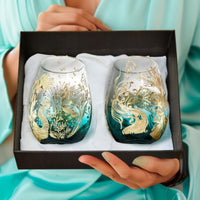Hi there,
Did you know that the temperature at which a wine is stored and served can have a noticeable impact on its flavor and aromatics?
Despite this, many who indulge are unaware of wine temperature best practices and are thus missing out on the drinking experience the producer of a specific bottle intended to create.
Furthermore, a wine that is stored in an area with improper temperature control can actually age ahead of schedule, reducing the amount of time you have to enjoy it and permanently altering the flavor qualities that make it unique.
At Cornet Barcelona, we want our customers to enjoy an extraordinary tasting experience each time you uncork a bottle, so we thought we would cover some of the most frequently asked questions we hear regarding wine temperatures and serving recommendations.
We’re confident that by taking a few moments to learn more about these techniques, you and the rest of our valued clients will benefit from an enhanced, more satisfying savoir-faire for years to come.
Does Wine Freeze?
This is one of the most popular questions that wine merchants (and we too) are approached with. The answer? Yes, absolutely. But the temperature at which a bottle of wine will freeze depends on its alcohol content, so different wines will solidify at different levels of exposure when chilled.
Usually the question “Does wine freeze?” is immediately followed up with “Can wine still be served after it has frozen?”. Again, the answer is yes. Once the wine has completely thawed, there is no reason it can not still be enjoyed. Sometimes, small crystals can form on the cork or the bottom of the bottle when a wine is exposed to extremely cold temperatures, but this is completely normal and does not affect the sapidity of the wine itself.
At What Temperature Does Wine Freeze?
As mentioned above, the answer to “What temperature does wine freeze?” is entirely dependant on the ethanol (or alcohol) content of the bottle in question.
We recommend using the table below when determining the freezing point for your selection:
|
ALCOHOL PERCENTAGE |
FREEZING POINT |
|
0% |
0°C |
|
10% |
-4°C |
|
15% |
-6°C |
|
20% |
-9°C |
|
25% |
-12°C |
|
30% |
-15°C |
At What Temperature Should You Keep Red Wines?
It is a common mistaken belief that red wine should be served at room temperature. At Cornet Barcelona, we have become accustomed to debunking this myth for the many clients who ask us “Should red wine be chilled?”. In many instances, we are met with a confused look when we reply “Yes”. And yes, this is our answer every time, even if the question is “Should Pinot Noir be chilled?”.
Red wine is actually best served cool, since serving it at room temperature or warmer can repress the wine’s natural fruit tones and result in a sharper, more alcohol-forward taste.
As a general rule of thumb, red wines should be served between 13-18 degrees Celsius.
Thus, we recommend storing red wines in the refrigerator for about an hour before serving. It’s also advisable to use awine decanter when serving, as it will allow your wine to aerate and traps any sediment at the bottom of the vessel, ensuring each glass is as smooth and as flavorsome as possible.
To elevate your wine experience even further, our well-suitedstemless wine glasses are another must-have. Using an ideal wine glass for your preferred wine type ensures that all of its distinct aromas are released and that the distracting burn of ethanol is kept away from the nose.
At What Temperature Should You Keep White Wines?
If you’re wondering should white wine be chilled, the ideal white wine temperature is significantly cooler than that of red wines, ranging between 7-13 degrees Celsius.
When most consumers think about chilling wines, they automatically think of whites, since they are the most commonly served after being refrigerated. But it’s important to note that white winescan be over-chilled, so being aware of how long your white wine has been cooled is important.
The lighter and fruitier your wine is, the cooler it should be when served. White Zinfandel, Riesling, and Pinot Grigio wines fall into this category and are typically served at around 7 degrees Celsius, or 45 degrees Fahrenheit.
Dry, more acidic wines, however, such as Chardonnays and Sauvignon Blancs, do best at slightly warmer temperatures, with most being served at 10 degrees Celsius, or 50 degrees Fahrenheit.
Should Rose Be Chilled?
After finding answers to the questions “Do you chill red wine?” and “Do you chill white wine?”, wine drinkers are not often left perplexed when it comes to Rose, since it falls somewhere in the middle.
There is no need to second-guess, however, since Rose is subject to the same temperature best practice as white and reds— serve chilled if you want to maximize flavor.
As a rule of thumb, a temperature of 7-13 degrees Celsius, or 45-57 degrees Fahrenheit, is recommended for Rose.
When possible, the bottle should be chilled for approximately an hour, and then taken out of the fridge and left to sit for 20-30 minutes before serving.
Conclusion
To summarize, below is a brief recap of the questions we’ve answered in this post.
1. Can you put wine in the freezer?
Answer: Yes, but be aware of how quickly your wine is chilling, and remove when the ideal temperature has been reached. If the wine solidifies, it is still okay to consume after it thaws.
2. Do you refrigerate wine?
Answer: Yes, most categories of wine, including reds, should be served below room temperature and thus should be refrigerated.
3. At what point does wine freeze?
Each wine has its own alcohol percentage, which influences its freezing point. It’s always worthwhile to research the freezing point for your specific bottle. We recommend to use the table provided as guidance.
Salud y amor y tiempo para disfrutarlo!









